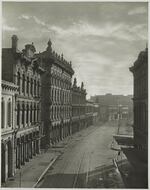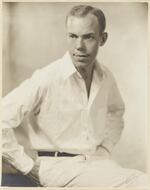A stroll down the streets of Portland 150 years ago would have revealed an ornately decorated architectural world, harkening to the streets of Venice.
“The years between 1853 and 1889 were considered the cast iron age in Portland. The exuberance of the time was decoration,” said Bill Hawkins, an architectural historian and author based in Portland. Cast iron was an affordable way to embrace the grandeur of the Victorian Era.
But by the 1930s, Portland was plagued by floods, and the streets were rapidly filling up with automobiles with no place to park. The city drew up plans to raze these buildings, making room for a new era.

Minor White, Front Avenue, Portland, Spring 1939, gelatin silver print
The Minor White Archive, Princeton University Art Museum, © Trustees of Princeton University
In 1939, the Works Progress Administration hired a promising young photographer named Minor White to document the buildings before they were demolished. At the time, White was just starting his artistic journey. But he would soon become one of the 20th century’s most important photographers.

Minor White, 1936
The Minor White Archive, Princeton University Art Museum, © Trustees of Princeton University
For the next year and a half, White took hundreds of photographs of Portland, particularly along Front Avenue. Though his assignment was purely documentary, White used the opportunity to develop his craft and define his style.
“I think that we can see Minor’s fully-fledged aesthetic begin to emerge in the work that he does for the WPA,” Julia Dolan of the Portland Art Museum said.
Today, most of these beautiful cast iron buildings are gone. But thanks to the artistry of White, we’re left with a compelling, artistic account of their time in Portland.
“A good photographer can make us feel how hot the sun is at it beats down in the middle of summer. Or, how misty the fog can be, or how dark a February Portland night can be,” Dolan said.
“It doesn’t look anything like that anymore. You can’t even imagine it. And that’s why his photos are so important to the city,” said Val Ballestrem of the Architectural Heritage Center.
Resources and Information
- Portland Art Museum - Minor White Attributions
- Princeton University Art Museum - Minor White Attributions
- Architectural Heritage Center - "Parting Shots: Minor White's Images of Portland, 1938-1942"
- Portland Art Museum - "In the Beginning" Minor White's Oregon Photographs